Last October, Next Thing Co., makers of the popular C.H.I.P. platform unleashed the C.H.I.P. Pro, a very capable Linux system on a tiny board. The goal of the C.H.I.P. Pro is to be the brains of a project or product, similar to the Gumstix boards from an ancient era long before the Raspberry Pi.
Introduced alongside the C.H.I.P. Pro was a fantastic little device. The GR8 module is a complete Linux system on a chip, with an ARM Cortex-A8 processor and 256 MB of RAM, all on a relatively small BGA chip. This is a drop-in part that gives any piece of hardware a Linux brain.
There was a datasheet at the time the C.H.I.P. Pro and GR8 module were released, but a datasheet can only go so far. What you really need to use a Linux system on a module is a massive tome filled with descriptions of registers and all the hardware nooks and crannies needed to get the part working. At CES this week, Next Thing Co. brought what everyone has been asking for: an NDA-free complete register documentation for the core they’re using on the GR8 module. This is 400 pages of spiral-bound goodness that will tell you how to do everything with this chip.
Using the C.H.I.P. for products
When the C.H.I.P. was first released, it was easy to write it off as a board glomming on to the popularity of the Raspberry Pi. However, Next Thing Co. didn’t start with the C.H.I.P. – they started with Otto, an animated gif camera built around the Raspberry Pi compute module. The Otto was successful, but the compute module is a little expensive, so Next Thing Co. turned their attention to building a modern, inexpensive version of the old Gumstix boards.
The C.H.I.P. Pro and GR8 is the culmination of this work, and already a few companies have used it in production. At the Next Thing Co. suite, they showed off a new version of the Outernet base station powered by the C.H.I.P. Pro, and the TRNTBL, a wireless, Bluetooth, Airplay, and Spotify-connected turntable.
To illustrate how easy using the C.H.I.P. Pro in a product is, the guys at Next Thing Co. removed the Pi-powered guts of an Otto and replaced it with a C.H.I.P. Pro. There wasn’t much inside – just a battery, camera module, and a few bits and bobs. That’s great for anyone who wants to build a product that needs a relatively fast chip running Linux, and the stuff from Next Thing Co. makes it easy.


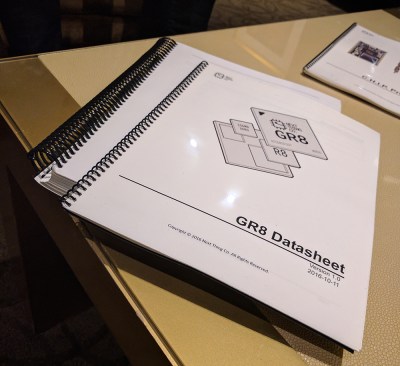
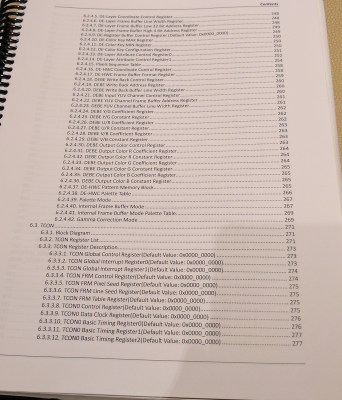
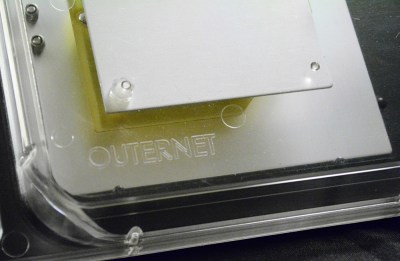

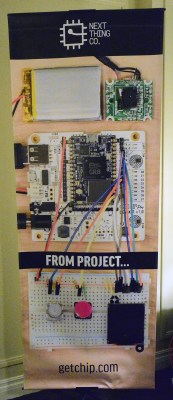
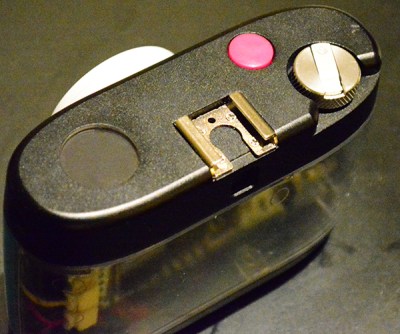














How much does it cost? In quantity?
Would you like me to good that for you?
google.
doh!, own goal…..
That would have been a nice bit of info in the article.. :)
Looks like
C.H.I.P. Pro Dev Kit $ 49.00
C.H.I.P. $ 9.00
C.H.I.P. Pro module: $16.00
I’d like to add that the CHIP and the CHIP Pro module both include Wifi and Bluetooth at that price, unlike the Raspbery Pi Compute Module or the Raspberry Pi Zero, which require you to add a USB Edimax type dongle, and possibly a USB 2.0 hub, easily doubling or quadrupling the price. The CHIP is also considerably faster. It doesn’t include an HDMI port, but for embedding into things it’s sort of a moot point.
According to their web page, you can actually buy GR8 chip. Pricing is simple – 6 USD in any quantity. Same principle applies for module which uses this chip – 16 USD in any quantity.
“That’s great for anyone who wants to build a product that needs a relatively fast chip running Linux, and the stuff from Next Thing Co. makes it easy.”
It also means everyone on HaD is going to have a field-day when they get their Pi- powered products home. Board swap and let the fun begin.
But I want something as beefy as the Pi3 (double the RAM would be preferable though) while having the size/form-factor, accessories & USB ‘slave’ functions of the Zero .
Getting rid of that nasty proprietary blob is a very close follow-up tho’
So, is this an A8?
R8.
I is confused, why 400 page spiral bound??? Where is the PDF we can all download?
Dead tree is easier on the eyes.
Exactly. Im confused, this article only tells me they released 2 PICTURES of a dead tree, there are no links to download, or even order that dead tree.
> Where is the PDF we can all download?
It IS an open source project, the first place to check would be their Github:
https://github.com/NextThingCo/CHIP-Hardware/blob/master/CHIP%5Bv1_0%5D/CHIPv1_0-BOM-Datasheets/Allwinner%20R8%20User%20Manual%20V1.1.pdf
so it was online for over a year? December 22nd 2015
Yes, this is a Non Article.
Of course the full register docs exist, but what is the point of this story if the info is still not available in the Real World?
Very disappointing.
While i agree with the spirit of your remark, I can’t help but laugh at the idea that a downloadable pdf is more real than a printed book.
You have to appreciate the irony in that…..
Google much?
https://github.com/NextThingCo/CHIP-Hardware/blob/master/CHIP%5Bv1_0%5D/CHIPv1_0-BOM-Datasheets/Allwinner%20R8%20User%20Manual%20V1.1.pdf
Unfortunately, it seems that the GR8 module is not yet readily available, requiring submission of contact details to their sales-folk with details of the project.
Wow, this is huge. Now, don’t put that into BGA. Instead, put that into TQFP. Caps on package of course. That would change the world. Make it so! Or do we have to wait another 5 years? ;)
… and don’t forget the flash.
From the Otto photo looks like the camera interface is USB vs CSI interface. Wonder if C.H.I.P will ever get CSI support.